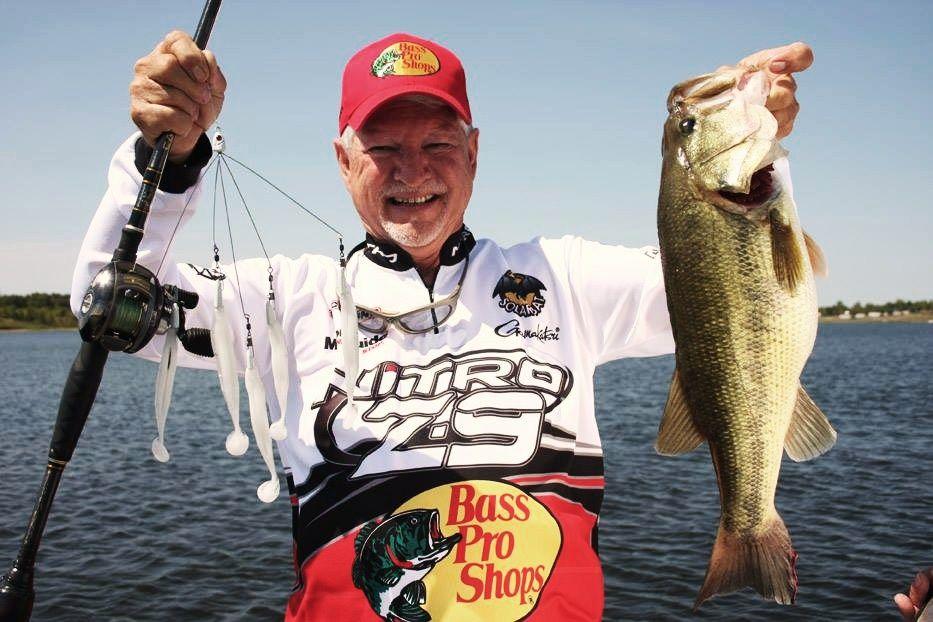
Ned Kehde
Members-
Posts
13 -
Joined
-
Last visited
Recent Profile Visitors
5,605 profile views
Ned Kehde's Achievements

Bleeding Shiner (1/89)
3
Reputation
-
 jig&pig reacted to a post in a topic:
Smallmouth Bass For Truman Lake
jig&pig reacted to a post in a topic:
Smallmouth Bass For Truman Lake
-
 shark bait reacted to a post in a topic:
The Life and Times of Stacey King: 1986 to 2016
shark bait reacted to a post in a topic:
The Life and Times of Stacey King: 1986 to 2016
-
 Quillback reacted to a post in a topic:
The Life and Times of Stacey King: 1986 to 2016
Quillback reacted to a post in a topic:
The Life and Times of Stacey King: 1986 to 2016
-
Stacey King of Reeds Spring, Missouri, began competing on the Walmart FLW Tour at Lake Travis, Texas, on Feb. 12, 2007, and at that event, he won $12,000. Since that day, he has competed in 70 FLW tournaments, including four of the prestigious Forrest Wood Cup events, and won $427,000. Read more: http://www.in-fisherman.com/bass/the-life-and-times-of-stacey-king-1986-t0-2016/#ixzz3xWnc3zlt View full article
-
Stacey King of Reeds Spring, Missouri, began competing on the Walmart FLW Tour at Lake Travis, Texas, on Feb. 12, 2007, and at that event, he won $12,000. Since that day, he has competed in 70 FLW tournaments, including four of the prestigious Forrest Wood Cup events, and won $427,000. Read more: http://www.in-fisherman.com/bass/the-life-and-times-of-stacey-king-1986-t0-2016/#ixzz3xWnc3zlt
-
The initial and only response from the Missouri Dept of Conservation was that they have never stocked reservoir-strain smallmouth bass in Missouri, fearing that they would adversely affect the stream-strain smallmouth bass in the Ozark region. In addition, they said that they don't want to stock species that aren't native to the waterways. After several more petitions to several MDC fisheries folks, one biologist, who has now retired, responded and said that our requests would be pondered by the appropriate folks in the MDC. But many months have transpired, and we haven't heard a word. They also failed to answer our ponderings about why they have stocked muskie, wipers and striped bass, which aren't native species, as are the trout that are stocked in various Missouri waterways. What's more, many of the small feeder creeks to Truman and Lake of the Ozarks, such as Deer Creek, Big and Little Buffalo creeks and Cole Camp Creek, were stocked with smallmouth bass by anglers and one MDC employee in the early 1950s. Therefore, the smallmouth bass that abide in those tributaries aren't natives in the classical sense. It is not a monetary factor, because the U.S. Army Corps of Engineers has offered to give Kansas an ample supply of reservoir-strain smallmouth bass to stock in Corps reservoirs, and, of course, Truman is a Corps reservoir. Therefore, if Kansas can get them, why can't Missouri get them and stock them in Truman?
-
The folks who mentioned that they are interested in the history of the stocking of reservoir-strain smallmouth bass in Oklahoma can contact Gene Gilliland at GGillOkla@aol.com. He is a fine angler and fisheries biologist. And he might render an opinion about smallmouth bass in Taneycomo. For anglers who have expressed an appreciation of the smallmouth bass on this forum, I would like to note that John and Roger Kehde, of Sedalia, Mo., and I have been petitioning the Missouri Dept.of Conservation to stock reservoir-strain smallmouth bass into Truman Lake. We have witnessed what has transpired with the stocking of reservoir-strain smallmouth bass in several reservoirs in eastern Kansas, and one of these reservoirs, which is Melvern Lake, Kansas, lies at the headwaters of Truman. Some folks have argued that the limnology of Truman isn't favorable to smallmouth bass. But we have seen smallmouth bass flourish in Eufaula Lake, Okla., producing state-record-size specimens, and the limnology of Eufaula doesn't fit the classical definition of a smallmouth bass waterway, and neither does Coffey Lake, Kansas, which contains an impressive population of smallmouth bass. To our chagrin, we haven't been able to motivate the MDC to stock reservoir-strain smallmouth bass. Therefore, we are hoping that some of the smallmouth bass devotees who participate in this fine forum will contact the MDC and ask them to stock reservoir-strain smallmouth into Truman
-
We can contact Gene Gilliland at GGillOkla@aol.com, and he will tell us the history of reservoir-strain smallmouth bass stockings in Oklahoma. So far reservoir-strain smallmouth recruitment at Taneycomo has been meager; thus if anglers want them, they will have to convince the MDC to periodically stock them. And perhaps they will eventually find a recruitment niche; the fisheries world is an inscrutable endeavor; thus pays not to give up hope. And you can fight Mother Nature; Leonard Jirak of Hartford, Kansas, and the Kansas Dept of Wildlife and Parks has fought her a lot and won some battles.
-
There is a difference between reservoir-strain and stream-strain smallmouth bass. Traditionally, stream-strain smallmouth bass have a difficult time recruiting in a reservoir, but Taneycomo isn't a traditional reservoir. In eastern Kansas, we have a 5,000-acre power-plant reservoir that supports a significant population of reservoir-strain smallmouth bass, and during a calender year, the water temperatures in this lake range from 38 degrees to 90 degrees. In recent years, some anglers in Kansas have asked the biologists to raise reservoir-strain smallmouth bass until they are eight-inches long and stock them the way they stock wipers, channel catfish and trout in the small reservoirs in easter Kansas. The Chinese fishmongers have shown the world that it is a relatively easy task to raise 12" to 13" largemouth bass, and Leonard Jirak of Hartford, Kansas, and Kansas Dept of Wildlife and Parks, has shown us that it is relatively easy to raise smallmouth bass in a summer to be six to eight inches long, and stock them in late September in a reservoir and allow them to become three- to five-pounders. Perhaps in order to develop a decent smallmouth bass fishery at Taneycomo, anglers will have to convince the folks at the Missouri Dept of Conservation to periodically raise reservoir-strain smallmouth bass and stock them into Taneycomo. The obstacle to that idea is that the MDC has a prejudice against reservoir-strain smallmouth, fearing that they will adversely affect the stream-strained smallmouth bass in the Ozarks. Years ago before Beaver Lake was stocked with reservoir-strain smallmouth bass that was a legitimate concern Some folks think that Table Rock's smallmouth bass population has been enhanced by the reservoir-strain smallmouth bass that have escaped from Beaver. And it is assumed the byproducts of Beaver's smallmouth bass bass have already affected the stream-strain smallmouth in the tributaries of Table Rock, and since some of Table Rock's smallmouth bass have washed into Taneycomo, it's likely that they have affected the stream-strain smallmouth in Taneycomo and Bull Shoal's feeder creeks.
-
Even Gete Hibdon is using braid nowadays on some of his spinning outfits. Gary Yamamoto is using on his spinning tackle, and Shin Fukae, the new master of finesse, occasionally uses it.
-
A number of Kansas finesse anglers are using either 6- or 8-pound-test Stren Microfuse. A six-foot fluorocarbon leader is attached with either a J-knot or a Seaguar knot. Some anglers find that the Seaguar knot is easier to tie when the wind is blowing.
-
Dear dtrs5kprs: Your ponderings about the adverse effects of the radical fluctuations of Truman Lake's water levels on smallmouth bass are interesting. We can note that Melvern Lake, which lies at the headwaters of Truman Lake in Osage County, Kansas, experiences similar fluctuations. What’s more, Melvern’s water clarity isn’t clear as Truman’s. Yet despite the stained water, Melvern’s smallmouth bass are recruiting, and the smallmouth bass fishing is better at Melvern than it is at Stockton Lake, Missouri. We suspect that one reason why the smallmouth bass fishing is better at Melvern is because its Kansas Department of Wildlife and Parks’ biologist, Leonard Jirak of Hartford, Kansas, stocked reservoir-strain smallmouth bass into Melvern, but the Missouri Department of Conservation didn’t stock reservoir-strain smallmouth into Stockton. Instead, Stockton’s smallmouth bass population is a river-or stream-strain species that abided in the streams before Stockton was impounded, and often they don’t fare as well as reservoir-strain smallmouth do. In addition, the bountiful populations of smallmouth bass that abide in Jacks Fork, Eleven Point and Current rivers are regularly plagued by wild fluctuations of water levels. The only way that we will know if smallmouth bass will flourish in Truman Lake is to have the MDC stock reservoir-strain smallmouth, and they should do it several times throughout a span of 10 years. To our dismay, we must note that we haven’t received a reply from any of the folks at the MDC to whom we sent our letter asking them to consider stocking smallmouth bass into Truman Lake. Sincerely, John, Ned and Roger Kehde
-
It should be noted that anglers at Grand Lake, Oklahoma, are petitioning their fisheries biologists to stock reservoir-strain smallmouth bass. But it looks as if that will not occur because it is feared that the reservoir-strain smallmouth bass will adversely affect a genetically distinct strain of smallmouth bass that abide in several of the streams that feed Grand Lakes. The Oklahoma biologists note that the mixing of the gene pools would result in the loss of native stocks," and that is a serious and legitimate concern. The smallmouth bass, however, that abide in Truman’s feeder streams are not a unique strain.
-
Mr. Lilley ask for some data. Here is one example: In 1994, 394 six-inch smallmouth were stocked into Melvern Lake, which lies on the Marais des Cygne River and eventually becomes the Osage River and flows into Truman Lake. Melvern is a flatland reservoir. Its waters are relatively stained. According to most anglers’ perspectives, the clarity ranges from several inches at its worst to about five feet on the best of days. (Secchi disc readings, however, might be a tad better than the eyes of anglers). Melvern’s shoreline is graced with miles of rock and gravel, as well as long expanses of riprap, which provides smallmouth bass with many suitable areas for recruitment. And those 394 smallmouth bass have done a splendid job of recruitment. Nowadays, anglers who use finesse tactics can regularly catch 30 to 100 smallmouth bass an outing from mid-April to mid-September. Occasionally, an angler will tangle with some three- to four-pounders or bigger specimens, but most of the smallmouth bass range in size from 11 inches to 14 inches. Melvern has an 18-inch size limit for smallmouth bass. And unless an angler is in a tournament-frame of mind, getting 30 to 100 bites an outing from a gaggle of medium-sized smallmouth makes for an enjoyable outing indeed.
-
To Missouri Department of Conservation and Concerned Anglers: A sizeable number of anglers want the Missouri Department of Conservation to stock reservoir-strain smallmouth bass into Truman Lake by following the practices that the Kansas Department of Wildlife and Parks and Oklahoma Department of Wildlife Conservation have developed during the past 20 years. For example, the KDWP has developed a dynamic smallmouth bass fishery on the upper reaches of Truman’s watershed at Melvern Lake. And elsewhere in Kansas, significant smallmouth bass populations exist at Coffey County, El Dorado, Milford and Wilson reservoirs. And in 2008, the KDWP will begin stocking reservoir-strain smallmouth bass in Clinton and Perry lakes. Likewise, the ODWC has created a number of fine smallmouth bass fisheries, stretching from Lake Texoma in the south to Skiatook Lake in the northeast and at several venues in between. In the August-September issue of the FLW magazine, Hal Schramm, a fisheries biologist who writes for a variety of publications, wrote about the manifold benefits of the ODWC’s stocking program at Skiatook, noting that smallmouth bass were stocked in 1990 and 1991, and through natural recruitment the population grew more than threefold by 1999. The Oklahoma state-record smallmouth bass is an eight-pound, three-ounce specimen that was caught by Steve McLarty on March 4, 2006 at Lake Eufaula, and some knowledgeable observers note that the limnology of Eufaula and Truman are similar. In addition to the Oklahoma reservoirs, such as Eufaula, that have established smallmouth bass populations that reproduce naturally, the ODWC stocks smallmouth bass every year in a few reservoirs where the smallmouth bass are unable to recruit. Lake Hefner is one of those. This water-supply reservoir lies within the Oklahoma City metropolitan area and receives a yearly stocking of 5,000 to 10,000 fingerling-sized smallmouth bass. At Truman, the nursery areas for the largemouth bass have diminished as the reservoir has aged. Consequently, its largemouth bass recruitment has suffered, and the largemouth bass fishing has dramatically deteriorated from its heydays. This decline, however, has created a fine nursery area for smallmouth bass recruitment. All that is needed is to have the MDC stock reservoir-strain smallmouth into Truman. And because of the great successes achieved by the fisheries biologists in Kansas and Oklahoma, we suggest that MDC’s fisheries biologists consult with their Kansas and Oklahoma colleagues, such as Leonard Jirak of Hartford, Kansas, and Gene Gilliland of Norman, Oklahoma, who will explain the ins and outs of how a vibrant smallmouth bass fishery can be created at Truman. Sincerely, John, Ned and Roger Kehde
-
To Missouri Department of Conservation and Concerned Anglers: A sizeable number of anglers want the Missouri Department of Conservation to stock reservoir-strain smallmouth bass into Truman Lake by following the practices that the Kansas Department of Wildlife and Parks and Oklahoma Department of Wildlife Conservation have developed during the past 20 years. For example, the KDWP has developed a dynamic smallmouth bass fishery on the upper reaches of Truman's watershed at Melvern Lake. And elsewhere in Kansas, significant smallmouth bass populations exist at Coffey County, El Dorado, Milford and Wilson reservoirs. And in 2008, the KDWP will begin stocking reservoir-strain smallmouth bass in Clinton and Perry lakes. Likewise, the ODWC has created a number of fine smallmouth bass fisheries, stretching from Lake Texoma in the south to Skiatook Lake in the northeast and at several venues in between. In the August-September issue of the FLW magazine, Hal Schramm, a fisheries biologist who writes for a variety of publications, wrote about the manifold benefits of the ODWC's stocking program at Skiatook, noting that smallmouth bass were stocked in 1990 and 1991, and through natural recruitment the population grew more than threefold by 1999. The Oklahoma state-record smallmouth bass is an eight-pound, three-ounce specimen that was caught by Steve McLarty on March 4, 2006 at Lake Eufaula, and some knowledgeable observers note that the limnology of Eufaula and Truman are similar. In addition to the Oklahoma reservoirs, such as Eufaula, that have established smallmouth bass populations that reproduce naturally, the ODWC stocks smallmouth bass every year in a few reservoirs where the smallmouth bass are unable to recruit. Lake Hefner is one of those. This water-supply reservoir lies within the Oklahoma City metropolitan area and receives a yearly stocking of 5,000 to 10,000 fingerling-sized smallmouth bass. At Truman, the nursery areas for the largemouth bass have diminished as the reservoir has aged. Consequently, its largemouth bass recruitment has suffered, and the largemouth bass fishing has dramatically deteriorated from its heydays. This decline, however, has created a fine nursery area for smallmouth bass recruitment. All that is needed is to have the MDC stock reservoir-strain smallmouth into Truman. And because of the great successes achieved by the fisheries biologists in Kansas and Oklahoma, we suggest that MDC's fisheries biologists consult with their Kansas and Oklahoma colleagues, such as Leonard Jirak of Hartford, Kansas, and Gene Gilliland of Norman, Oklahoma, who will explain the ins and outs of how a vibrant smallmouth bass fishery can be created at Truman. Sincerely, John, Ned and Roger Kehde





